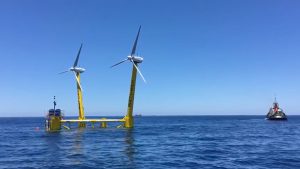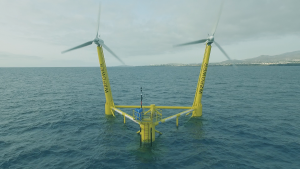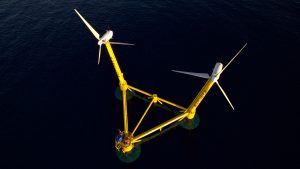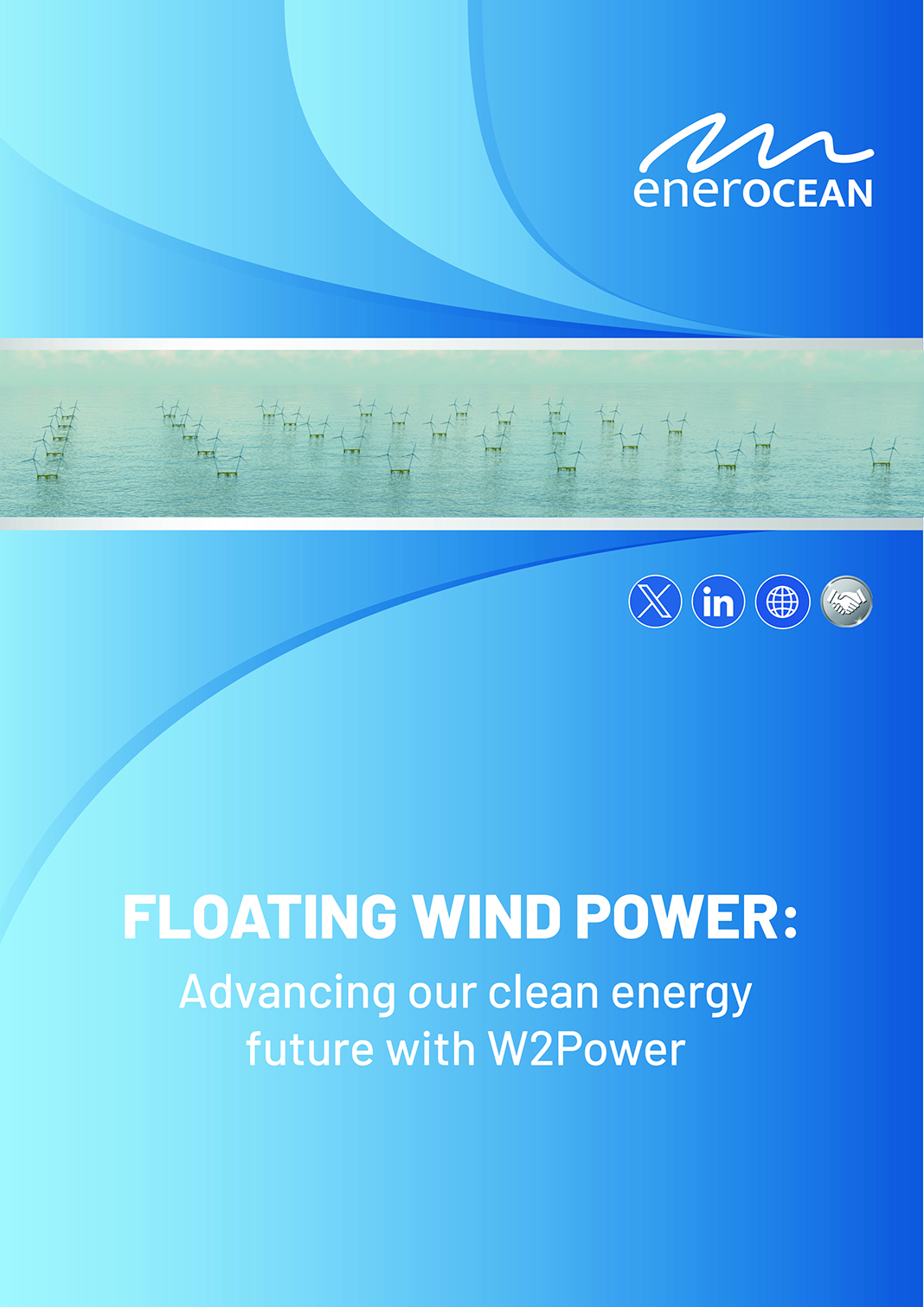W2Power is an innovative adaptation of proven, mature offshore technologies to the needs of emerging deep-water offshore wind.
EnerOcean’s business scope covers resource analysis, feasibility studies, development and commercialisation of enabling technologies in marine renewable energy engineering. The company was established in 2007 and is the owner and lead developer of W2Power. With its industry-leading rated power (MW) per tonne of platform steel, even at the roughest sites, W2Power is the most cost-competitive mature floating wind solution, allowing commercial developments starting today. Industrial investors are on board since 2018, and a strategic investment and partnership agreement with Plenitude (Eni) was signed in 2022.
In this new eBook, Innovation News Network spoke to Pedro Mayorga, CEO, and Jan Hanssen, Co-Founder of EnerOcean, about the intricate dynamics of floating wind power and the groundbreaking innovations offered by EnerOcean’s W2Power platform.
The world of renewable energy is undergoing a profound transformation, driven by the urgent need to combat climate change and achieve decarbonisation goals.
Floating wind power has captured the imagination of energy business managers, investors, and policymakers in recent years, offering a promising pathway towards clean and sustainable energy generation. This technology extends the benefits of offshore wind to countries with limited shallow waters, breaking down geographic barriers to renewable energy adoption.
It paves the way for a higher proportion of offshore wind energy to contribute to the global energy supply, offering greater flexibility to align with stringent environmental regulations—a pivotal factor in specific markets.
Government policies and incentives play a decisive role in supporting the growth of floating offshore wind, especially in emerging markets marked by regulatory uncertainties. Regulatory certainty is identified as a foundational requirement, along with a commitment to maintaining stable rules throughout project lifecycles.
Governments must set clear, long-term targets and offer realistic and transparent updates to ensure successful investments in floating wind power.
The eBook explores W2Power, a pioneering solution that promises to reshape the field of floating wind and renewable energy as a whole. This cost-efficient platform features the maturity needed for seamless project planning and execution, supported by rigorous certification processes.

Key advantages of W2Power, such as its lightweight semi-submersible floating structure, use of a pair of already commercialised turbines, and self-orientation system, are examined in-depth. These characteristics are poised to revolutionise offshore wind development by optimising steel usage, enabling the use of existing ports, and reducing assembly and operational costs.
Elsewhere, the eBook examines the concept of multi-use as a potent driver for offshore wind technologies. The integration of mariculture with offshore wind emerges as a compelling example, demonstrating how combining uses can enhance sea space efficiency, benefit stakeholders, and mitigate environmental impacts.
As we navigate the evolving landscape of renewable energy, it becomes evident that floating wind power, exemplified by the W2Power platform, stands as a beacon of innovation and a driving force behind the transition to a cleaner, more sustainable future.
Could you explain why floating wind power solutions have become a focus for energy business managers, investors, and policymakers in recent years, especially in the context of decarbonisation goals?
Floating wind has been identified as a way to obtain the benefits of offshore wind for countries that lack shallow waters.
Even for countries with shallow waters, floating wind will allow to have less congestion in their seas. Floating wind also has fewer permitting problems.
Worldwide, floating wind will allow a higher percentage of offshore wind into the energy supply.
Having more options will make it easier for offshore wind developments to become compatible with environmental limitations. This is very important because it is central to certain markets.
What are the main challenges ahead for floating wind power? Addressing the positioning of national/regional markets, key milestones that could impact the sector’s growth trajectory, and regulatory uncertainty, where do you foresee floating wind power to be in 2030?
The main challenge to floating offshore wind is cost reduction. Compared to bottom-fixed offshore wind, the industry as a whole has much less experience in the development of floating offshore wind farms. This initial experience needs to become more frequent, and a variety of approaches need to be used.
We also have pressure to compete with other renewables. This does not mean that floating offshore wind needs to be the cheapest solution, but we must provide something with a higher value.
Additional benefits of floating offshore wind need to be added to compensate for a higher CapEx.

It is not clear where the market will be in 2030 but I’m optimistic that we will start to see major deployments by this time. For example, it would be great to see several hundreds of megawatts already connected or going online by 2030.
By 2030, there will be a big difference from what we see now.
What are some of the technological innovations and advancements that could help reduce the capital and operating costs of floating wind projects and contribute to achieving lower levelised cost of energy targets?
We need to see the application of cost saving methods in the manufacture and assembly of the platforms and turbines.
There will be cost-saving innovations that will benefit from the long-tradition of the naval and oil and gas industries. Methods from these industries will need to be used in the manufacturing of the floating units.
Another innovation that will be fundamental and will require significant attention is improving reliability of the critical components, such as the turbines and dynamic cables.
Advancing these components together with improving connections for fast installations will be crucial.
How do you see the role of government policies and incentives in supporting the growth of floating offshore wind, especially in emerging markets where regulatory uncertainty exists?
We need regulatory certainty. First, this will mean that we have clear rules that can be applied.
Next, because we are in a capital-intensive industry, we need to know that the rules will not be changed during the process.
We need to know that there will be a clear path for those rules to be adapted, so that changes that arise during the life of a project can be accounted for.
For floating wind for example, this uncertainty is not limited to those countries that still lack certain rules, but to some rules that need to be adapted to changes of conditions.
Some of the main markets that we foresee for floating wind have limits that are yet to be defined.
Governments need to provide long-term reliability on their targets and provide realistic and clear updates.
In the last five years, more and more countries have announced targets specifically for floating wind because of its growing prevalence.
However, we are now seeing the same countries push the dates or gigawatts for those targets without clear explanations.
The UK is a recent example of this, where the national target for floating wind was postponed.
This indicates that governments don’t fully understand the scale of the challenges when it comes to taking long term investment decisions.
As a company, we are following a few countries specifically, such as, the UK, Italy, Portugal, France, Norway and Japan, in addition to our home market Spain. Governments need to understand that if they make a planning decision for floating wind, it implies a very long lead time with a large budget.
How does the W2Power platform contribute to advancements in the field of floating wind and new renewable energy in general?
The W2Power platform is a cost-efficient floating wind solution that has the maturity level to be included in planning complete projects. We have gone into a deep certification process to prove the level of maturity needed.

Our well-thought-out design, that will have the industry’s lowest CapEx costs will be pivotal in helping floating wind make a real impact on the energy system.
W2Power was the first solution, for example, to demonstrate the possibility of using a single point mooring for floating wind in the open sea. We were also the first to demonstrate that it is possible to run two turbines as a pair without interference between them. These ideas were successfully sea tested.
In our current pipeline, we intend to use two ten or twelve-megawatt turbines, already today on the market and will be easy to get from a lot of manufacturers, with competition on price. Competitors using a single turbine floater will need to get the latest 20- or 24-megawatt machines which don’t even exist as prototypes today. By necessity, these will not be as tried and tested as those that have been sold already in significant quantities.
Could you provide an overview of the key advantages of EnerOcean’s W2Power floating wind solution, and what makes it unique in terms of cost-effective offshore wind development?
There are three primary elements reducing the cost of production. These beneficial characteristics are 1) the lightweight semi-submersible, 2) the use of smaller turbines at a lower height, and 3) the self-orientation of the system.
The benefit of the lightweight structure is that we are optimising the amount of steel per megawatt of power. This is very important.
Another solution is using a smaller draft. This means that we can use ports that already exist without going to specific ones further from the installation point. It also means that we do not need to reinforce or modify the harbours and ports.
Using a pair of smaller turbines means that we do not face the limitations that effect big turbines. Smaller turbines are lighter and result in a cheaper assembly. Lower height means that loads on the platform at sea are less, so it can use less steel than a platform for one huge turbine. It also means a lower OpEx because the components that we are going to use are smaller, easier to mobilise, yet produce the same power.
We have proven models and multiple vendors for these turbines.
Thanks to the self-orientation, we can use closely-spaced turbines. We are also removing the yawing system of the turbines.
This will remove one of the more unreliable components, because usually, this element takes a long time to repair if there is a breakage. The platform benefits from the self-aligning system.
These design aspects are main causes of the reduction in CapEx and OpEx.
Could you elaborate on multi-use as an added class of design drivers for offshore wind technologies? How does multi-use add value to all stakeholders: public planners, developers, investors, and marine ecosystems?
We have considered several potential multi-use combinations of our platform. Some of these are related to energy.
One of the more interesting combinations is the mix of offshore wind and fish farming. We have worked closely with fish farming experts and through collaborative discussions we have identified significant synergies between the two uses.
We have also found how this can be made of interest to the source of capital that will need to be mobilised.
Multi-use will need to be developed without complicating the permitting process. At the same time, we need to see that the benefits from combining the two uses outweigh the added complication.
When the government and investors understand that multi-use will ensure that sea space is used more efficiently, and there are also less environmental interactions, it will emerge as a clear option for many markets.


